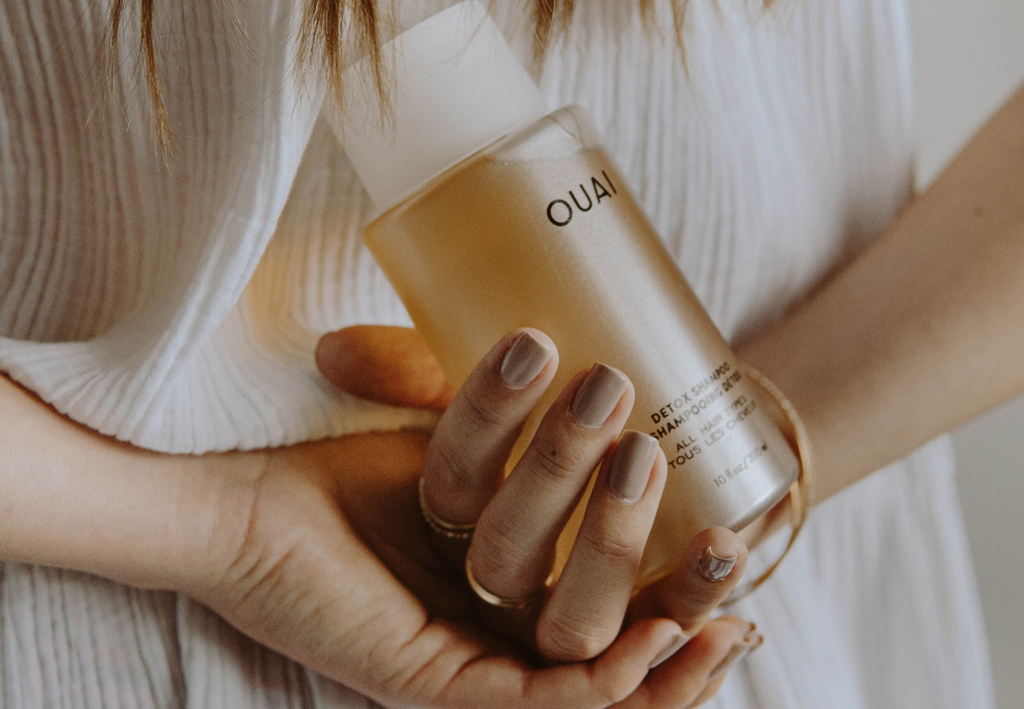FEATURED IN : WOMENS HEALTH
Your Ultimate Guide to Growing Out Your Hair, According To Experts
Growing out your hair can be a laborious process, especially if you’re going from a really short style, to a longer mane. It can take months – and sometimes years – to achieve the desired length naturally so it’s no surprise that you might want to speed up the process.
So before you give up and chop it off again, there are a few things you can do to maximise how quickly your strands grow. We spoke to Grow’s Expert Hair Stylist Belinda Keeley of Chumba Concept Salon to get her top tips to getting longer locks faster.
So, what is normal hair growth?
Hair grows at an average rate of about half an inch a month, and there are a range of factors that influence the rate, including hormones, stress, genetics and ageing. This means your hair grows at different rates at different times in your life. For example, during pregnancy your hair growth accelerates, thanks to a surge of estrogen and progesterone, especially after the first trimester. But after you give birth, the hormone levels crash, often leading to postpartum hair loss.
Here’s how you can give it a helping hand:
1. Get regular hair cuts
“Most people have probably heard this statement countless times but don’t actually understand how it works. After all, cutting your hair regularly to get your hair to grow quicker just sounds counter-intuitive. The truth is that your hair grows at the same rate no matter how often you cut it. BUT, cutting your hair regularly does remove split ends (which can be the thing that stops some of your hair from growing longer),” says Belinda. “Urgh, split ends – those little tears and splits at the ends of your hair that can make your hair become dull, dry, and tangled. A split end is caused when the protective outer layer of your hair (the cuticle) is damaged. While there are many products on the market that claim to repair or reseal split ends, the truth is that split ends cannot be repaired (unless they are cut off)! The best thing to do for split ends is to get regular haircuts trimming the ends and keep your hair nourished and healthy. Damaged hair can stall your process of growing it out, so you’re better to cut it off and work with healthier strands!”
2. Stop going to bed with your hair soaking wet
“We all know it’s a lot easier to just hop out of the shower and jump straight into bed without bothering with the hair dryer. But if you haven’t already noticed, going to bed with your hair wet can actually damage your hair. Besides the damage that moisture going to do to your pillow and your health (things like breeding bacteria), going to bed with your hair drenched can cause damage. Your hair is weakest whilst wet and while you sleep and it’s likely to cause breakage, especially in blondes. Along with a few knots or kinks that will be hard to get out or style in the morning. Rather than going straight to bed with wet hair, do a luxe hair treatment a few hours before bed to ensure your hair is nourished and strengthened from the inside out and then let it dry naturally. We love Grow Haircare’s Anti- Breakage Hair Mask which is formulated with Amino Acids and key actives to help strengthen hair deep from within and protect the hair surface, preventing damage and breakage caused by environmental stress, chemical treatments or over styling.”
3. Dry your hair with care
“While we’re on the topic of wet hair, a common haircare mistake that many people make is blow drying their hair when it’s dripping wet. Unfortunately, this can do a lot of damage to your hair and is something that should be avoided. Yes, we know it can be tempting to jump out of the shower and save time drying hair with a hot blast of the hair dyer, however all of that heat on your still-wet hair will only damage your hair and leave your locks susceptible to frizz. Try to wait until your hair is at least 80% naturally dry before hitting it with the hair dryer. The reason for this is because wet hair is typically far weaker than dry hair, so any heat or pulling of the hair is making it more susceptible to breakage and damage. In fact, when wet, your hair can stretch to 30% of its length so stretching it any further (i.e. with a brush when blow-drying) can lead to significant damage. Also be wary of the heat settings on your hair dryer or hair styling tools – stick to the medium or low heat settings, avoiding the extra hot settings whenever you can. And while we’re on the topic of drying your hair with care, another tempting move that many people fall into the bad habit of is vigorously towel drying their hair. Again, we know people do it to save time when it comes to drying wet hair, however as pointed out previously, your hair is more susceptible to damage when it is wet. Avoid vigorously rubbing hair with a towel when you get out of the shower, instead pat dry your hair, or wrap in a towel for a period of time and then leave it to naturally dry (when you can)!”
4. Stop using silicones based products on your hair
“We’ve all likely heard this before, however unfortunately silicones in haircare products can be hard to escape. Silicones are an ingredient found in many supermarket shampoos and treatment products and whilst they initially make hair look shiny and new, they add another barrier layer to hair strands and prevent moisture from penetrating the hair shaft. The worst part about silicones is that they do an amazing job at covering up the damage we have done to our manes. So, whilst our hair can look great when using silicone-based products, the reality is underneath that build-up, hair can be brittle, lifeless, dull and full of split ends. Ultimately you want to know the true health of your hair so you can get it in a better condition to actually grow! So, if you’ve been using a silicone-based shampoo for a while now, try giving your hair a detox with a silicone free shampoo and conditioner. It will remove the build up and get your hair on the right track.”
5. Protect hair from the elements
“Lifestyle and environmental factors can have a huge effect on the hair, resulting dull, brittle and damaged hair. Things like sun, chlorine, smoke and pollution all can have the potential to damage because particulate matter (tiny bits of soot, dust, and other residue) can settle on the hair and scalp, which can cause irritation and damage. The solution? Try to avoid them when you can! While that might be easier said than done, your hair will definitely thank you for it!”
6. Put away the hair styling tools
“These days most people’s work from home routine can mean much less hair styling which is a great thing for the hair! Try to minimise the amount of times you’re using heated tools on your hair because too much heat can lead to brittle, damaged hair and split ends. Heat-based styling tools such as hair straighteners and hair dryers are great but are better used sporadically (or avoided if you can). To minimise the amount of times you’re using these types of tools, consider using a dry shampoo to get more longevity out of your hair style.”
7. Use shower temperature to your advantage
“Many people don’t realise how the temperature of your shower can affect your hair in many ways. A cold shower can be great for the hair thanks to its ability to flatten hair follicles and lock in moisture, resulting in shinier, healthier and stronger hair. On the other hand, a hot shower can both damage and be beneficial to the hair (depending on how you look at it). Hot showers can risk removing oils from the hair and scalp which help protect hair from further damage. However, hot showers can also encourage blood flow to hair follicles which can make hair conditioning treatments work better. The best thing for your hair? Alternate the kinds of showers you have, ensuring you have an understanding of how it could be affecting hair. “
8. Be careful not to strip your hair of its natural oils
“Stripping your hair of its natural oils is a big no no, but one that can happen pretty easily thanks to a common haircare mistake – overuse of shampoo. Most people tend to fall into the trap of over-washing hair, which then kicks off a cycle of the scalp producing excess sebum (which of course makes you want to wash your hair again)! The best guidance on offer is treat your hair according to the hair you have, not the hair you’d like to have. That means really taking notice of what it needs and giving it attention as per it requires (rather than habit). Falling out of the trap of over-washing hair can be a difficult transition for some because you have to allow your hair to get a little oily in the process.”
9. Use a scalp scrub
“To understand the health of our hair better, it is important to look to the root (pardon the pun) of it all – the scalp! Many people don’t realise that our scalps actually have a lot to do with our hair health, so it’s important to look after those as well! Just like you would keep your skin in check with dedicated daily cleansing, your scalp needs regular attention too. We always recommend cleansing and exfoliating your scalp and to do this, invest in a quality scalp scrub like Grow’s Stimulating Scalp Scrub. This is formulated with natural sea salt and peppermint oil to effectively eliminate impurities and remove product build up from the scalp. It will detox, refresh and restore balance to your hair and scalp, whilst purifying and leaving your scalp restored. Fun fact, a scalp scrub can assist with the prevention of hair thinning and shedding, so it’s a perfect addition to your haircare routine if you’re looking to grow out your hair.”
10. Invest in the right haircare products
“If you want your hair to grow faster, you need to invest in the right products that will encourage better hair growth. Haircare products and overall hair health plays a huge part in the way hair looks, feels and styles. Hair that isn’t maintained is not only going to look unkempt, but it will stall any dreams you have of growing it out. A person’s haircare products are vitally important to their hair health and that includes just the basic necessities like a really great shampoo and conditioner. Try to avoid shampoo and conditioners that contain silicones because whilst it can temporarily make hair look shiny, it actually coats the hair and will weigh it down over time (the product build up will make it look flat not to mention the havoc it can create for your colourist). Also try to choose products that promote scalp health and combat hair thinning so that in between haircare appointments at the salon, you can maintain your hair health.”
Wants to know more tips? Head out to Women’s Health for more!




